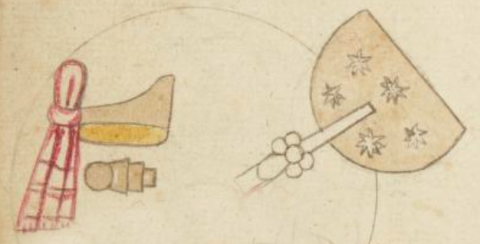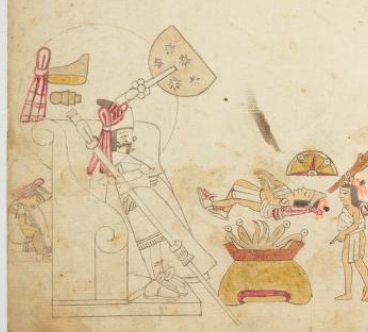Motecuhzoma (Xocoyotzin & Ilhuicamina) (Azca24)
These painted black-line drawings are of the compound glyphs for the personal names, Motecuhzoma Xocoyotzin (on the left) and Motecuzoma Ilhuicamina (on the right). shows a tan and gold diadem with a red and white tie. This diadem (the xiuhhuitzolli). The one on the left shows a glyph for lord (tecuhtli), and tecuh- is the middle part of the name of Motecuhzoma. The possessive mo- (your) is not shown visually. Nor is the -zoma ending to the name. Another object in the compound–perhaps a lip plug–is apparently a semantic element associated with this ruler. Finally, on the right, an arrow pierces (mina) a sky (ilhuicatl) that is a tan-colored half-circle with white stars on it, combining for Ilhuicamina.
Stephanie Wood
These glyphs are not glossed, and so we would normally classify them as examples of iconography. But they are so similar to other, known glyphs, that we are calling them glyphs here. A bas relief stone carving on the underside of the lid of the so-called "Caja de Moctezuma Xocoyotzin," Museo Nacional de Antropología e Historia, Salón Mexica, shows a similar xiuhhuitzolli, which the museum signage refers to as the "imperial headdress." The compound glyph on the stone also has some face ornamentation and a speech scroll (tlatoa, to speak), indicating that this man had the power to speak, being a tlatoani. The glyph here from the Codex Azcatitlan has fewer added elements, and it lacks the hair (tzontli), which can serve as a phonetic complement to -zoma. See our record for Motecuhzoma (Mdz15v), which includes a photo of the base relief carving. Also, the examples below show that the diadem alone can serve as a glyph for Motecuhzoma, perhaps both the elder and the younger.
Marc Thouvenot's project, Vignettes, includes images of both the younger and the older Moteuczoma from the Códice Matritense de la Real Academia: https://vignettes.sup-infor.com/imagen/5-RA_01_051r_e and https://vignettes.sup-infor.com/imagen/5-RA_01_051v_c.
Stephanie Wood
post-1550, possibly from the early seventeenth century.
Jeff Haskett-Wood
emperors, empires, rulers, gobernantes, emperadores, imperios, diademas, Montezuma, Moteuczoma, labrets, enchufes, tapones, labios, bezotes, adornos labiales, jewelry, jollas, lip plugs, lip-plugs, teuctli, nombres de hombres, personas famosas

Motecuhzoma, the name of two rulers of the empire, the first was Ilhuicamina, who came to power in the mid-fifteenth century, and the second was Xocoyotzin, who was ruling at the time of the Spanish invasion, https://nahuatl.wired-humanities.org/content/motecuhzoma
tecuh(tli), lord, https://nahuatl.wired-humanities.org/content/tecuhtli
zoma, to frown in anger, https://nahuatl.wired-humanities.org/content/zoma
ilhuica(tl), sky, heavens, celestial realm, https://nahuatl.wired-humanities.org/content/ilhuicatl
mina, to shoot with arrows, pierce with arrows, https://nahuatl.wired-humanities.org/content/mina
posiblemente, El Que Se Muestra Enojado, El Que Flecha al Cielo
Stephanie Wood
The Codex Azcatitlan is also known as the Histoire mexicaine, [Manuscrit] Mexicain 59–64. It is housed in the Bibliothèque Nationale de France, and hosted on line by the World Digital Library and the Library of Congress, which is “unaware of any copyright or other restrictions in the World Digital Library Collection.”
https://www.loc.gov/resource/gdcwdl.wdl_15280/?sp=24&st=image
The Library of Congress is “unaware of any copyright or other restrictions in the World Digital Library Collection.” But please cite Bibliothèque Nationale de France and this Visual Lexicon of Aztec Hieroglyphs.








